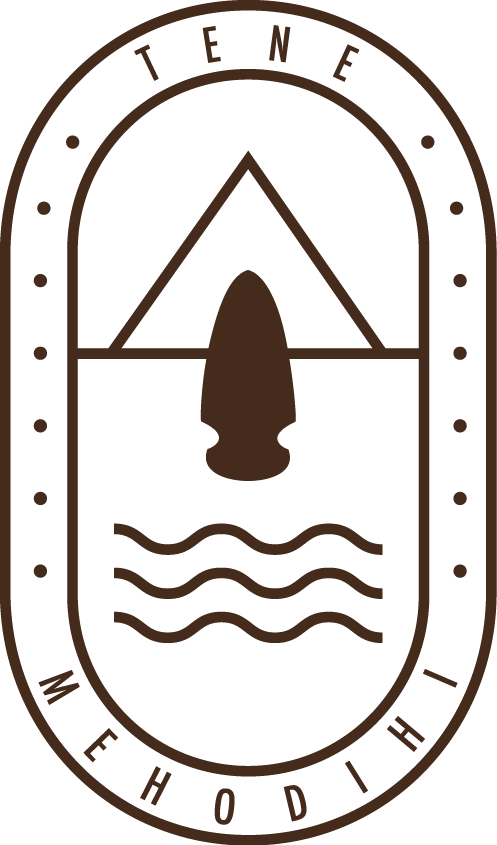

Our map is the result of several collective remembering sessions following the 2019 Tene Mehodihi Adventures.
During the Pandemic, participants met online to draw our journeys; after, these drawings were combined to make this artistic rendition of the trails. The two 2019 adventures were between Łuwechōn and Tlēgōhīn and from Goat Mountain to Eve’s Cone. The hiking groups all met at Eve’s Cone and finished in Tlēgōhīn together.
Follow our journey by the direction of the obsidian markers, and click them to see images and media samples from our Adventures.


Our Ancestors’ Trail Adventure takes youth on the Ancestral Tahltan route between Łuwechōn and Tlēgōhīn. On our Adventure we took two detours to Sāzia to Tahltan sheep hunting areas and a mining exploration camp; and the other side-trip was to Eve’s Cone on Mount Edziza, where the team met with the Obsidian Adventure group traveling from Goat Mountain.
This project has been made possible through the 2020 Canada Council digitization grant to digitalize the Tene Mehodihi Our Ancestors’ Tail Exhibition and to make a creative map. Tsēmā Igharas and Sophia Biedka, project administrators, would like to thank Candis Callison and Nadja Kunz for their guidance and support. We would also like to thank Joni Shinkel for their web design and work to publish the Adventure Map.
Tene Mehodihi members who met to draw their memory maps: Curtis Rattray, Nathan Skubovius, Nadja Kunz, Shesley Calison-Hanna, Sage Novak, Alysha Hawkins, Freya Podlasly, Ocean Van Mierlo, and Sophia Biedka; these memory maps were assembled and painted by Tsēmā Igharas, conceptualized and designed by Tsēmā Igharas and Sophia Biedka, and the web design is by Joni Schinkel.
We would also like to acknowledge the following hikers from the 2019 Tene Mehidihi Adventures:
Our Ancestors’ Trail
Mikaela Nole
Sylis Inkster
Brayden William
Raedyn Morrin
Diego Gray
Alysha Hawkins
Melina Louie
Josh Louie
Nate Johnny Hawkins
Nathan Skubovious
Shesley Calison-Hanna
Brittany Seymour
Nadja Kunz
Kathleen Morin
Robert Williams
Marianne West
Sage Nowak
Obsidian Discoveries
Kyla Hilbach
Freya Podlasly
Ocean Van Mierlo
Curtis Rattray
Tsema Igharas
Sophia Biedka
Brendan Gray
Sophia Biedka

In 2019 our Tene Mehodihi Obsidian Discoveries team helicoptered into the primary Tahltan obsidian quarry on Edzīza’e (Mount Edziza). The team consisted of Tahltan guide Curtis Rattray, Tahltan artist Tsēmā Igharas, settler filmmaker Sophia Biedka, settler archaeologist Brendan Gray; Tahltan youth: Freya Podlasly, Kyla Hilbach and Ocean Van Mierlo. We explored the site for several days discovering, recording, and learning about this rich Tahltan resource, used by our Tahltan ancestors, since time immemorial. Very little archaeological work has been conducted in this region. To our knowledge, this project is only the third time an extensive archaeological survey has been conducted in this area.
Our study identified hundreds of unrecorded belongings and artifacts, and directly led to further discoveries of rare, organic ice-patch artifacts on a following expedition. The Obsidian Discoveries team trekked across Edzīza’e, from Goat Mountain to Eve’s Cone where they met with the other Tene Mehodihi team, traveling from Iskut, and continued on together to Telegraph Creek. Finding obsidian on the trail connected youth to our Tahltan ancestors who traveled the trail before them. Traditionally, our ancestors carried obsidian, a precious Tahltan resource, back to our communities for use and for trade.
Dudāt (obsidian) from Edzīza’e volcanic complex is an extremely useful and valuable material, with a trade trail recorded as far south as Mexico. The outcrop sources are densely covered in evidence of past quarrying and tool making, something the Tene Mehodihi youth and leaders observed throughout their time on the Kitsu Plateau.
Climate change is melting ice patches that have been in place for thousands of years. The melting ice patch on Kitsu Peak has revealed organic material, which is very rare. Usually organic material decomposes quickly; however, these artifacts were preserved in a cold anaerobic environment . These artifacts are extremely rare and analysis of these items is ongoing. Without the Tene Mehodihi hike, this ice patch would likely not have been inspected and these items would likely have been reclaimed by the land.